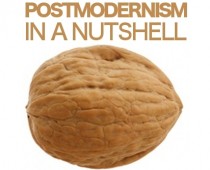Postmodernism is much easier to understand if you develop first an understanding of modernism. So let’s begin there. The age of the ‘modern’ describes the period of changes to Western society that occurred during the late 19th and early 20th centuries. Society was becoming largely industrial and cities were forming and multiplying. Modern thought is commonly defined by belief in ‘progress’, ‘rationality’, and ‘absolute knowledge’. These beliefs involve the ideas that the search for knowledge should be guided by rational inquiry, and that progress of the world will be achieved through intellectual advancement. Put simply, modern thought involves the idea that technological and scientific advancements, and the search for truth, will better the world.
If I had to portray modernism in an image I would picture the functioning cogs of a machine. Much like the ideals of modernism, a cog represents function and order, as well as technological advancement and the industrial age.
Bureaucracy is a great example of modernist thought at work in society. The business world of western society is known for its bureaucratic organisations. German sociologist Max Weber defines bureaucratic administration as “domination through knowledge”. Bureaucracy involves efficient administrative organisation and demands that every person or employee is treated equally. It represents the rationalisation of culture, which we discussed as one of the key elements of modern thought.
You may be wondering why bureaucracy is still prevalent today if it is an aspect of modern culture and theory suggests that we have passed through a postmodern age. This demonstrates one of the challenges of postmodernism. There is no straightforward way of drawing a line between the modern and the postmodern, some would argue that the postmodern is just a part of or an extension of the modern era, where others would argue for their distinct separateness. There is no single date that marks the beginning of the postmodern era. There are multiple theories about the first postmodernists or when postmodernism originated. This difficulty lies in the fact that postmodernism is not a unified intellectual movement with a singular goal or perspective. However, there are a number of recognisable themes that appear throughout the plethora of different versions of postmodernism. For now let’s focus on making sense of these basic themes of postmodernism by comparing them with the principles of modernism.
Defining postmodernism is a difficult process because the term can be used differently between disciplines. During the 1970’s, the term postmodernism gained popularity as a term used to describe a period of architecture and art. In this period, people were becoming ‘exhausted’ with the literature and architecture of the modernist movement. This postmodernist artistic movement was characterised by pluralism, wit and a sense of nostalgia and fun. Some key pop cultural artefacts from the movement that you might be familiar with include the film Bladerunner, the novels of Kurt Vonnegut and Thomas Pynchon, the architecture of Philip Johnson, the rise of MTV, the cyberpunk movement, and even the television cartoon The Simpsons. A search for cultural artefacts today that depart from this postmodern movement will be met with great difficulty. When studying postmodernism it is important to keep in mind that ideas about postmodernism in society and politics can differ greatly from ideas about postmodernism within the arts and culture. For the sake of keeping things simple, the majority of Postmodernism in a Nutshell’s discussion will concern postmodern literary theory.
Now, with the assistance of a very helpful comparative table produced by Hicks (2011) let us explain the ideals of postmodernism by juxtaposing them against the ideals of modernism. Postmodern theory largely opposes the fundamentals of modern thought. Firstly, postmodern theorists reject the western concept of ‘progress’: the idea that intellectual and technological advancement will lead to the ultimate betterment of society. This rejection of progress also incorporates a rejection of ‘grand narratives’ or ‘metanarratives’, which are commonly found in modern social theory. The concept of ‘metanarratives’ was introduced and critiqued by elite postmodernist Jean-Francois Lyotard (1979). Metanarratives are grand over-reaching stories that claim to explain the validity of all smaller stories, such as knowledge and experience. Big examples of metanarratives are religion and science, as well as Marxism. Metanarratives suggest that ‘absolute knowledge’ exists. Absolute knowledge and truth suggests that human knowledge can be objectively determined with the assistance of science, technology, society and politics. Postmodern theory rejects the idea of absolute knowledge; believing instead that all human knowledge is subjective and can have no absolute meaning. This postmodern belief in subjective experience also leads to the rejection of the modern ideal of rationality. Rationality believes in rigorous scientific (not subjective) reasoning. If modern thought is defined by belief in ‘progress’, ‘rationality’, and ‘absolute knowledge’, postmodernism can be defined by a belief in irrationality, subjective knowledge and rejection of progress. Postmodernism is difficult to define because of its numerous forms, but can also be as every day as The Simpsons, which practices postmodern techniques. I would argue that it has been defined most concisely by Lyotard, who defined it as scepticism and questioning of grand narratives, such as progress, that attempts to understand everything underneath its scope. Postmodern thought questions the idea that technological and scientific advancements, and the search for absolute truth, will better the world.
As promised, here is a helpful table that illustrates some of the key differences between the pre-modern, modern and postmodern:
If the table above appealed to you, or you would like more information about it, the author Professor Stephen Hicks has published his entire book ‘Explaining Postmodernism’ online for you to view. Follow the link below:
http://www.stephenhicks.org/publications/explaining-postmodernism/
Hicks, S 2011, Explaining Postmodernism: Skepticism and Socialism from Rousseau to Foucault, Scholargy Publishing, Tempe.
Lyotard, JF 1979, The Postmodern Condition: A Report on Knowledge, Manchester University Press, Manchester.




